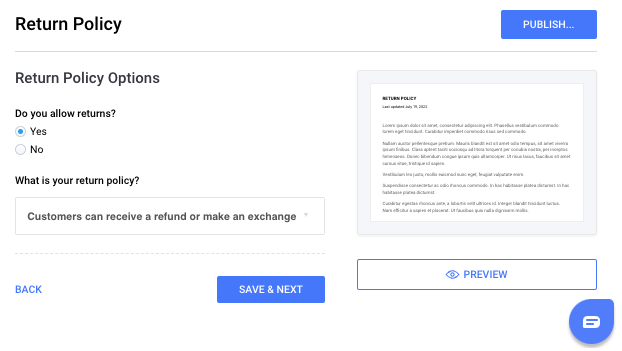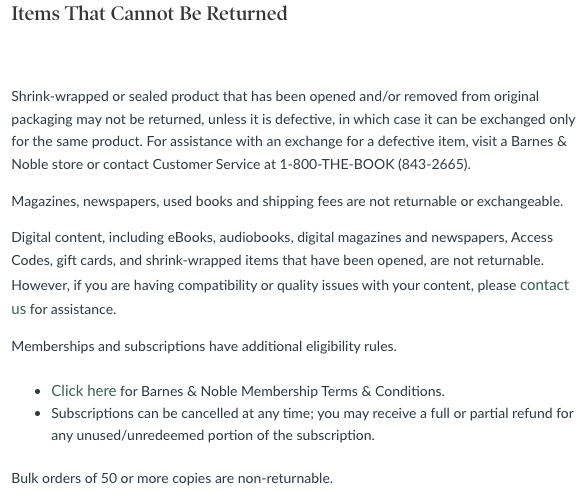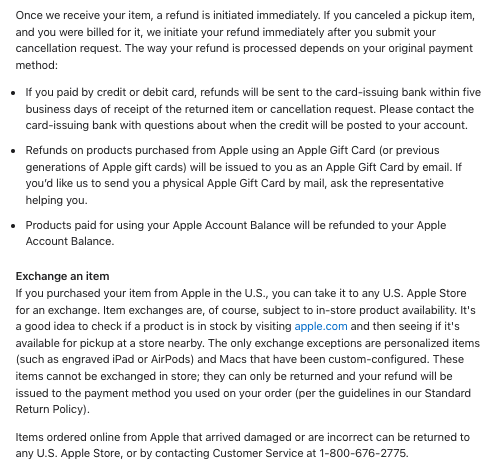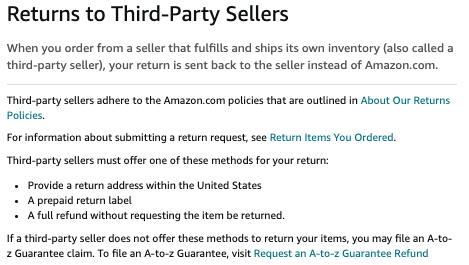Writing a clear, straightforward return policy gives your customers a good experience when returning something, leaving them with a satisfied opinion of your store.
In this guide, I discuss what a return policy is and why they’re so important, then teach you how to write a return policy that’s concise, effective, and helps you retain more customers.
- What Is a Return Policy?
- Why Is Return Policy Important?
- Return Policy Solutions
- How To Write Your Return Policy
- Common Questions to Answer in Your Return Policy
- What Your Return Policy Needs to Include
- What To Avoid in Your Return Policy
- Tips for Writing a Good Return Policy
- How Often Do You Need to Update Your Return Policy?
- Where to Display Your Return Policy
- Summary
What Is a Return Policy?
A basic return policy explains to customers if you accept returns and offer any refunds or exchanges after they’ve purchased an item they no longer want.
It sets your customers’ expectations about:
- If you accept returns, offer refunds, exchanges, or store credit
- What items are eligible for returns, and in what condition
- Fees customers pay when returning an item
- How long customers have to submit a return
- Time estimates for processing the return
Because return policies are closely associated with shipping and handling questions, they often have a clause that links to a business’s shipping policy.
Additions to Your Return Policy
You could write a basic return policy, or supplement it with one of the following.
No Refund Policy
You could include a no refund policy, a type of return policy that explicitly informs customers that you do not provide refunds on items they purchase.
You can write a strict no refund policy or provide more leniency by offering customers item exchanges or store credit.
While you’re not legally required to have a return policy, in some US states, by default, you must provide full refunds on items unless you post a policy stating otherwise.
All Sales Final Policy
Alternatively, you could add an all sales final policy which is a return policy informing your customers that there are no refunds, returns, or exchanges on items after purchase.
Businesses commonly use this policy for sale or clearance items, customized products, or non-returnable items like delicates or perishables.
Money Back Guarantee
Another type of return policy might include a money-back guarantee, which promises your customers that they can return an item and receive their money back for any reason after making a purchase.
You might choose to write this policy on limited items or offer it as a way to encourage customers to finalize more sales.
Why Is Return Policy Important?
Return policies are important for businesses because they help set proper customer expectation, protect your business from fraudulent returns, and increase customer satisfaction.
Return Policies Set Proper Customer Expectations
A well-written return policy properly sets your customers’ expectations about their options if they purchase an item from you and are unsatisfied.
Return policies clearly outline the specific requirements for how, when, and under what circumstances shoppers can return goods.
Giving consumers access to it before they make a purchase prevents anyone from feeling surprised by the policies you have in place.
Return Policies Protect Your Business from Fraudulent Returns
An effective return policy helps protect your business from fraudulent returns by creating a consistent process that makes spotting irregular or inappropriate refund requests easier.
In 2022, 10.7% of online returns were deemed fraudulent (National Retail Federation). The most common types of return fraud businesses cited included:
- 50% — wardrobing fraud, i.e., inappropriately returning used, non-defective merchandise
- 41.4% — returning shoplifted or stolen goods
- 20% — organized retail crime returns
Because your return policy acts as a binding agreement between you and the customer, you can include clauses allowing you to deny or pursue legal action against fraudulent returns.
Return Policies Increase Customer Satisfaction
A well-written return policy demonstrates that you care about your customers and their satisfaction with your goods and services.
Because most people expect to find a return policy on all ecommerce websites or apps, posting one also makes you more legitimate and trustworthy in a customer’s eyes.
If people can’t find a return policy on your site, they might feel it’s too risky to purchase from.
Return Policy Solutions
Before you begin writing a return policy, consider using one of the following methods to help guide you through the creation process.
Managed Solution
The easiest way to make a return policy for your website or app is using a managed solution like our Return Policy Generator.
Designed by our legal team and product experts, you can make a return policy in minutes simply by answering a few questions about your business. Our tool does all the work for you, so no writing, formatting, or guesswork is required.
Below, see just how simple and easy our generator is.

Our policy builder walks you through the most common return policy clauses and can be used to create any return, refund, or exchange policy.
If you get stuck or need help, just contact our customer support team.
Template
If you want to make a return policy for your business without spending a dime, consider using a free, downloadable return policy template.
All you need to do is download the template and fill in the blanks with information relevant to your website or app. Like our generator, you can customize the clauses and details to create any return policy you desire.
Using our template saves you time because most of the initial writing and formatting is completed for you.
So, what are the cons? There aren’t many — templates are free, easy to use, and simple to embed on a website or app.
However, if you want to design your return policy in a specific or non-traditional way, the traditional formatting may be too basic.
DIY
You can always take a do-it-yourself approach and try writing a return policy, which is probably why you’re this far into our guide.
Writing your return policy is an excellent option for businesses with solid, specific branding or who want more control over their policies’ voice, tone, and style.
The cons of this option are apparent — writing any website policy from scratch is challenging, takes up a lot of time, and requires research and patience.
But the rest of this guide will help you establish a process for writing a return that’s both efficient and thorough.
How To Write Your Return Policy
To write an effective return policy for your website, there are a few steps you should follow to outline and prepare your document.
Step 1: Choose The Formatting For Your Return Policy
The first thing you should do when writing a return policy is figure out how to organize it.
Because you’re writing it yourself, you can choose exactly how you want to format it, for example, you might:
- Use a traditional table of contents
- Organize it as frequently asked questions (FAQ)
- Use tables or bullet lists to organize the information
- Include graphics or company-specific branding
Be as creative or as traditional as you want in this step.
Step 2: Choose The Styling For Your Return Policy
Once you know the layout, figure out what fonts, colors, or other stylistic choices you’ll implement. Ensure people can easily read and see your colors and fonts on mobile devices and digital screens.
I also recommend making all internal links noticeable by changing their color, bolding, or underlining them.
If your company uses a style guide, apply it to the look and feel of your return policy.
Step 3: Pick The Right Return Policy Clauses
The most crucial step when writing your return policy is choosing the proper clauses to include.
Go through our list of standard and common return policy clauses and choose the ones relevant to your business.
Step 4: Create An Outline
Once you know the formatting, style, and clauses you want in your return policy, create a basic outline to help you build the actual document.
Be sure you order your clauses in a way that makes sense to your customers.
For example, state at the beginning if you accept returns and for what items, as this is the information most people seek.
Once your outline is complete, you’re ready to start writing.
Step 5: Use Easy-To-Read Language
When you finally start writing your return policy, use straightforward, easy-to-read language accessible to as many people as possible.
You want all of your customers to be able to understand the details of your policy, so avoid using confusing language, jargon, or legalese.
Take the time to define terms whenever necessary, and try not to overwhelm anyone with long, dense paragraphs or large blocks of text.
Common Questions to Answer in Your Return Policy
To help you write your return policy, consider your answers to the following questions:
- What items are eligible for returns or exchanges, and which are excluded? Many businesses exclude sale items, cosmetics, swimwear, or undergarments.
- What’s your time limit for returns and exchanges? You might limit returns to 30 days after delivery, purchase-date, or offer unlimited returns.
- Do you impose requirements for the condition of the items? You could accept only unopened items in original packaging or goods with tags still attached.
- How will you reimburse customers? Some businesses give refunds in the original payment form, store credit, or exchange a product of equal value.
- What fees do your customers need to cover? Clearly explain if you charge return shipping or restocking fees to avoid potential unhappy customers.
- How do customers start the return process? Let your customer know if they need to email customer service or submit a request through a form.
- How do you handle returns for lost or damaged items? State if you replace the item, offer a full refund in the original payment form, etc.
- How long will it take for customers to receive their refund? Give your customers an estimated timeline for when they should expect to get their return, refund, or exchanged item.
What Your Return Policy Needs to Include
To help you write your return policy, I’ve outlined how to create the most common clauses that typically appear in these documents.
If You Accept Returns, Refunds, or Exchanges
The first clause you write in your return policy should clearly explain if you accept returns and offer refunds or exchanges.
It’s entirely up to you if your business provides monetary refunds in the original payment form, store credit, exchanges for specific items, or even a mix of the above. Just be transparent.
You might format this clause as bullet lists, tables, or a graphically designed chart.
Below, see an example of this clause from L.L. Bean’s return policy, a clothing store.

Exclusions
You also should write a clause in your return policy that explains if any items are ineligible or excluded from being returned.
It’s common for businesses to exclude:
- Perishable items
- Swimwear
- Undergarments
- Personalized items
- Sales or clearance items
This clause can be organized using a simple bullet list or a more detailed table or chart.
Below, see how bookstore Barnes and Noble structures their exclusions clause.

Time Frame For Submitting Returns
One of the first things customers will look for is the length of your return window, so write a clause explaining how much time customers have to request a return, refund, or exchange.
Failure to disclose a time frame for returns may result in customers trying to ship back items months or even years after purchase.
A 15 to 30-day return policy is standard, but some businesses opt for 90 days, and others are willing to accept a return up to 365 days later, as long as you have the purchase receipt.
When writing this clause, remember that items with gift receipts are often expected to have longer return windows.
The example below also comes from the Barnes & Noble return policy, which extends returns for items with a gift receipt from 30 to 60 days.

Requirements For The Condition Of The Items
You should also write a clause in your return policy that lets customers know the requirements that must be met before a return will be processed.
Some common product requirements include:
- Any condition
- Any condition with proof of purchase
- Unopened, unused items in their original packaging
- Lightly worn items with tags still attached
If you fail to include this information, customers may attempt to return merchandise in conditions too poor to be resold.
See how L.L. Bean write this clause in the screenshot below.

How You Reimburse Customers
Write a clause in your return policy explaining to customers how they’ll be reimbursed after they submit a return.
You might choose any of the following:
- Refund in the form of original payment
- Store credit only
- Exchange for an item or equal value
Make this information clear, so you don’t catch anyone off guard if they submit a return.
Below, see an example of how tech company Apple writes this clause in their return policy.

Fees You Charge Customers For Processing Returns
When writing your return policy, clearly explain if you charge processing or handling fees when a customer submits a return. Tell them if they’re responsible for paying for return shipping or other overhead expenses.
You may need to charge a processing fee, provide only partial returns, or have returns mailed only to a specific facility.
But according to consumer surveys, free returns may be worth your while.
79% of shoppers want free returns
If free returns aren’t feasible, data also suggests that ease and efficiency regarding returns are significant factors consumers consider while shopping.
47% of shoppers want easy-to-print return labels
Below, see an example of a very succinct version of this clause from L.L. Bean.

How To Start The Return Process
Include a clause in your return policy that explains how customers should start the return process, for example:
- Email a specific customer service address
- Submit a return form through your website or app
- Return request portals
Keep this clause simple, so it’s understandable to as many consumers as possible.
Below, see how Apple wrote this clause in their return policy.

How You Handle Returns For Lost Or Damaged Items
Explain how your company handles returns for lost or damaged items in your return policy.
For example, you can only offer replacement items or give full cash refunds.
You can remove some liabilities from your plate by explaining that lost and damaged deliveries are beyond your control.
Whatever process you choose, outline it clearly, so your customers know what to expect if they receive a broken item.
The example of this clause below comes from L.L. Bean.

Estimated Timeline For Receiving A Refund
To make your return policy stand out, inform customers how long it takes, on average, for them to receive their refund after submitting a return.
This is important information that customers appreciate, but ensure you provide an accurate timeline to prevent unhappy reactions.
Below, see how Apple writes this clause in their return policy.

Third-Party Warranties
If you sell items across multiple platforms, a third-party warranties clause helps make returning items bought through the third-party service more efficient for you and your customers.
While this clause doesn’t apply to all ecommerce stores, it’s essential for people who sell goods through platforms like Amazon.
Below, see how Amazon explains third-party returns for sellers on the Amazon Marketplace.

Links to Other Policies
Your return policy is closely associated with other website policies and agreements, so put links to things like your shipping policy, privacy policy, and terms and conditions within a clause in your document.
See how Apple includes links to additional legal policies in their return policy.

Contact Information
At the end of your return policy, put your contact information so customers know how to reach you if they have further questions.
This also helps streamline your customer service processes because all questions will be directed to the proper channels.
Below, see how simply Barnes & Noble writes this clause in their return policy.

What To Avoid in Your Return Policy
Now that you know how to write a return policy, let’s go over a few things to avoid.
Avoid Confusing Jargon and Legalese
You should avoid using confusing language, jargon, and legalese in your return policy. Otherwise, it may be too dense and complicated for most people to understand.
You should also avoid poor formatting, like using font colors that are too light to read easily.
Avoid an Overly-Complicated Returns Process
Try to avoid making your return policy overly technical or complicated.
Covering every detail in a direct and informative way is important, but you don’t want to end up with a convoluted return policy your customers can’t comprehend.
It’s also best to avoid ambiguities or confusion when discussing the limits of your return policy.
This is especially critical regarding the restrictions on items available for return.
Avoid Inconsistencies Within Your Policy
When writing your return policy, be mindful that you’re consistent throughout the entire policy and avoid contradicting yourself.
Otherwise, your customers will read the policy and feel more confused rather than have their questions answered. Reread your policy to ensure it’s cohesive throughout.
Avoid Copying and Pasting
You should avoid copying another business’s return policy because doing so is plagiarism. It also won’t have the necessary details relevant to your store.
All businesses are different, so copying and pasting what works for someone else can lead to an atrocious, muddled policy that will turn shoppers off.
Tips for Writing a Good Return Policy
Now here are some helpful tips you can follow to make your policy stand out.
Make It Easy To Read
We’ve already mentioned this tip a few times, but make sure your return policy is easy to read. Otherwise, it defeats the purpose of the agreement.
You don’t want to end up in a scenario where people can access your policy but still can’t understand your process or how to initiate a return.
Remember that some people only skim headlines and read bullets. Keep this in mind when you structure your policy and guide your customers to the most critical information right up front.
Make It Easy To Find
You worked hard writing your return policy, so ensure your users can always find it by posting it in multiple visible locations throughout your website or app.
Format the link to your policy so it’s easy to spot. For example, you might bold and underline the hyperlink. Or, use a visible action button that is prominent and easy to navigate.
Don’t worry, I show you where to put your return policy later in this guide.
Set Clear Expectations
Set clear customer expectations in your return policy so no one feels caught off guard.
You know your customers best. As you write your policy, ask yourself:
- If I were a customer, how would I feel about this policy?
- Would I appreciate the free return shipping?
- Would I resent the company for offering only store credit?
Match Your Brand’s Voice And Tone
As you write your return policy, try to make the tone, voice, and style match the rest of your company’s branding and aesthetics. If you have a style guide, use it to shape your policy.
For example, if your website is playful and filled with color and graphics, make your return policy match that enthusiasm. Use graphs and charts to guide your customers as you inform them about their returns. Or, communicate updates about your policy through text messages that match your style and tone.
Be Honest And Actionable
Always be truthful about what you can and can’t do for your customers.
Customers should expect prompt service and updates regarding receipt and any next steps required. Otherwise, they tend to feel anxious if they don’t hear back for days or weeks.
Make it clear that customers can count on your business to keep to the timeline presented.
I also recommend giving them an avenue to file grievances or complaints. This will make your customers feel heard and position your company as a business that takes its customers seriously and takes action on their behalf when necessary.
Generate Goodwill
Take advantage of deals, special rates, and other promotions to generate goodwill with new and returning customers.
For example, an extended holiday return window could be an effective marketing tool.
Creating a longer time frame for the customer’s benefit also instantly positions you as a trustworthy company that can be counted on to stand by its products and values its customers.
Prepare Your Employees
After you’ve written and implemented your return policy, train your employees so they’re prepared to field questions regarding the procedure.
This makes things more efficient on your end and once again sets your business apart as a strong, customer-oriented company.
Include Contact Information
I know this seems obvious, but it’s vital to include accurate contact information in your return policy, this way customers know where to direct their questions.
Some businesses leave this part out, leading to more customer confusion and a lack of trust.
Make your return policy stand out and state how people can contact the proper department.
Play Fair
Mistakes happen, so if you mess up by shipping the wrong product, packaging something incorrectly, or sending something late, do your best to make it right for the customer.
How you handle mistakes could help build customer trust, attracting and retaining more sales.
Consider turning this into a clause in your policy as a sign of goodwill and transparency.
How Often Do You Need to Update Your Return Policy?
Your return policy is a living document you should review and update every few months.
For example, even if the returns process doesn’t entirely change, you might update your policy to reflect deals or promotions around certain holidays or market sales events.
Establish a process for communicating these changes to your customers through marketing emails, text messaging, or even social media posts.
Where to Display Your Return Policy
Whether your run an ecommerce website, app, or brick-and-mortar location, there are several common places where you should display your return policy:
- In your website or app footers
- Linked to website or app announcement banners
- On any payment screens or checkout pages
- In an FAQ or Help Center
- Within other relevant website policies
- Near cash registers and the entrance/exit
Let’s go over each of these locations in greater detail.
Website or App Footer
It’s a good idea to feature your return policy on every page of your website or app, so link it to static sections like the footer.
These days, customers expect to find your return policy in the footer of your website, along with links to other policies regarding privacy, data, and terms of use.
Announcement Banners
An announcement banner is a great place to link to your return policy, especially if you offer extended return windows or other promotions.
Announcement banners are more common on websites, but you can also use them in an app. They typically appear at the very top or bottom of users’ screens.
Payment Screens and Checkout Pages
You should present your return policy on payment screens and checkout pages before consumers finalize a purchase so they know exactly what your process is like.
It’s common to also link to your shipping policy, privacy policy, and terms and conditions agreement on these screens.
FAQ or Help Centers
Along with return policies, there are several other legal documents and agreements you want your customers to be able to access, so consider linking them to an FAQ page, help center, or privacy center on your site or app.
This organizes all necessary documents into one place, making it much easier for consumers to find answers to their questions.
Within Other Policies
As we’ve previously mentioned, return policies are often associated with shipping policies, no refund policies, all sales are final policies, and money-back guarantees.
So if you have these policies in place, link to your return policy within them, and vice-versa.
Near Cash Registers and the Entrance/Exit
If you also have a physical storefront, you should post a physical copy of your return policy by your cash registers and near the entrance or exit of your store.
Instead of printing the entire policy, you could also use a document QR code so customers can easily access it using mobile devices.
You can also put return information on the back of printed receipts.
Summary
With this guide at your side, you’re more than ready to write an effective return policy.
Remember to make it clear, direct, and easily understandable.
It should explain to your customers what items are eligible for returns, what the return window is, the required condition of returned items, and the specific steps that must be followed to obtain a refund.
Post it in multiple easy-to-find locations so all your customers are properly informed about your returns, refund, and exchange process.


